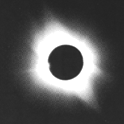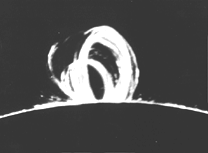|
(Files in red–history) |
 During a total eclipse of the Sun, when for a few minutes the Moon completely covers the Sun's face, a glow appears around the darkened Sun--the solar corona, the Sun's outermost atmosphere. Structures visible in the corona at such times suggest that they are shaped by magnetic fields, and therefore, that the corona consists of plasma. For instance, short "plumes" rising from the polar regions of the Sun look very much like field lines coming out of the end of a bar magnet, and they therefore suggest that the Sun, in addition to the intense fields of sunspots, also has a global magnetic field like the Earth's.
Structures observed in the corona above sunspots often have horseshoe-shaped outlines, again suggesting that they follow magnetic field lines. From the tops of such "arches" long streamers may extend, to distances of the Sun's diameter or even more, looking like pulled taffy, as if some process was pulling material away from the tops of the arches into space, (which is of course what the solar wind actually does). Astronomers have named them "helmet streamers" because of their resemblance to spiked helmets worn by knights (and also to those used by some German soldiers up to 1918).
|

